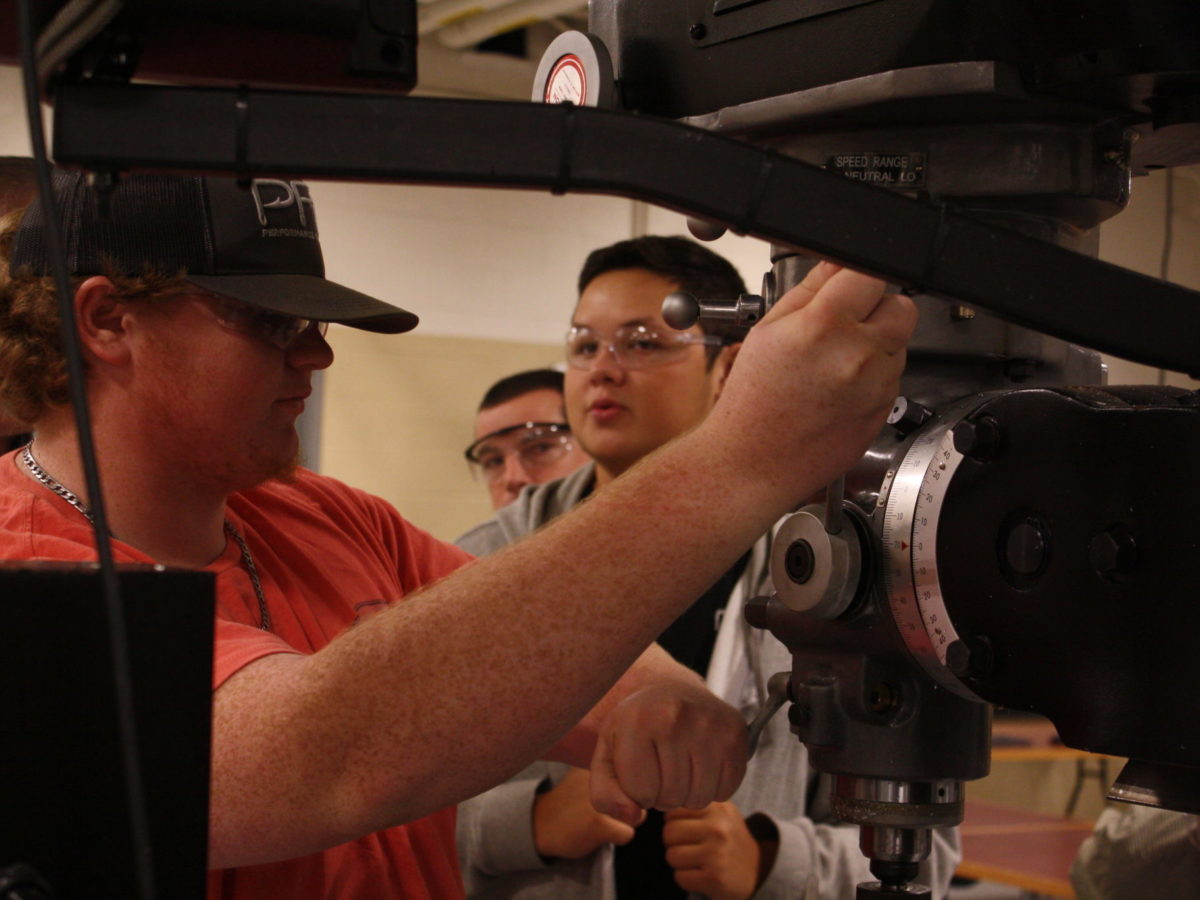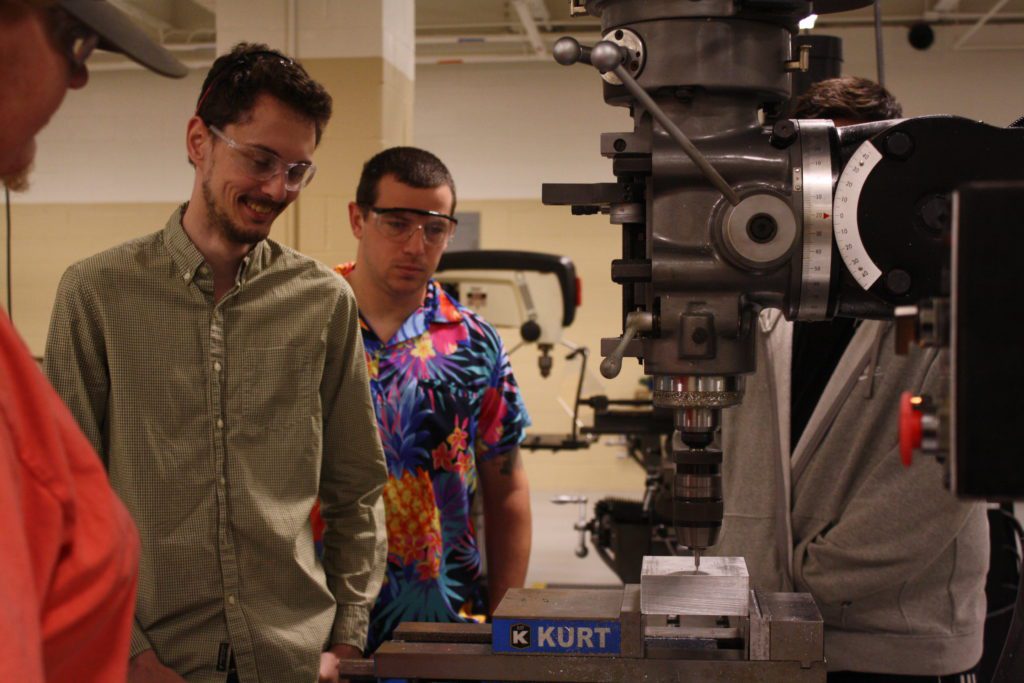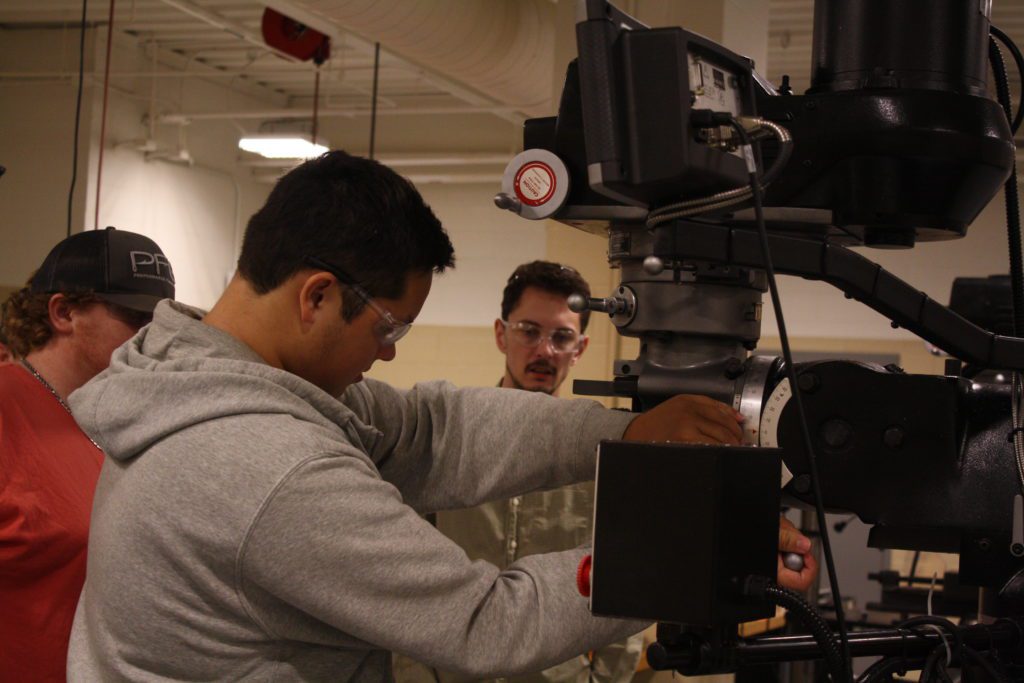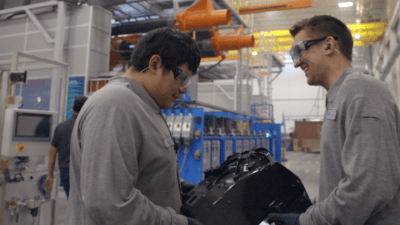

Share this story
- For every dollar students invest at SPCC, a report found they gain $5.20 in lifetime earnings. The college is working to further that impact by expanding its student services, meeting workforce needs, and connecting residents to high-paying jobs.
- The college recently expanded the Tyson Family Center for Technology, now more than 65,000 square feet, which includes new machining and teaching tabs. Nearly half of SPCC students are enrolled exclusively in workforce continuing education.
|
|
At South Piedmont Community College (SPCC), technology is kind of a big deal.
In March 2020, the college celebrated the renovated Tyson Family Center for Technology which brought the building to more than 65,000 total square feet. The expanded building – built in partnership with Union County – now includes a two-story student common area, manual machining labs, various teaching labs, offices, and eight classrooms.
The college serves about 9,300 students in Anson and Union counties – both nestled below Charlotte with around 260,000 total residents.
SPCC President Dr. Maria Pharr says new buildings are just one part of investing in students, families, and employers.
“This building demonstrates our commitment to putting the student experiences first,” Pharr said at the ribbon-cutting ceremony of the Main Building in fall 2021. “It’s a symbol of the transformative impact that South Piedmont Community College has on those who pass through our doors.”
In 2019-20, SPCC added $124.3 million in income to the economy, according a recent economic impact study – supporting 1 out of every 51 jobs in the service area. And for every dollar students invest at SPCC, the report found they gain $5.20 in lifetime earnings. The college is working to further that impact by expanding its student services, meeting workforce needs, and connecting residents to high-paying jobs.
Last year, the college used its federal COVID-19 relief funds to launch a new mobile app, SPCC Navigate, with hopes of helping more students access such opportunities by increasing centralized access to college resources. SPCC is also working to offer HyFlex instruction in the majority of its classes to increase student flexibility. HyFlex learning is a multi-modal instructional delivery method that allows students to attend class online or in person, synchronously or asynchronously, on a session-by-session basis.
And following the approval of a $32.7 million bond by Union County voters last month, the college also has plans to build a new, innovative Center for Entrepreneurship.
“The Center for Entrepreneurship is designed to help more business owners and entrepreneurs learn, connect, compete, launch, and grow their businesses sustainably. This business growth and development will benefit all residents of Union County with higher tax revenues, better-paying jobs, more opportunities to dine and shop, and the ability to create an overall more prosperous community.”
— South Piedmont Community College
Nearly half of South Piedmont’s students, according to 2020-21 data, are exclusively enrolled in workforce continuing education programming.
SPCC’s manufacturing program is one such offering. Established in 1999, there are about 250 manufacturing students at the college each year. For each completer of that program, lifetime earnings increase by $293,000, according to the economic impact study. The median annual wage for manufacturing jobs in 2020 was $47,648 – higher than the per capita income in both counties. Union’s per capita income is $37,667 and Anson’s is $22,483, according to census data.
There are more than 6,300 manufacturing jobs in South Piedmont’s service region spanning 30 occupations, according to the report, with jobs expected to grow over the decade.
“It’s about the talent and making sure that we are providing the best employees for our employers,” Pharr said.
The college wants to connect residents to, and train them for, high-paying jobs. Apprenticeships are one way SPCC is meeting such workforce needs.
‘It’s producing graduates’
The college currently offers apprenticeships with more than 20 local companies, said Dr. Mark Little, dean of SPCC’s School of Applied Sciences and Technology.
South Piedmont’s apprenticeship with medical technology manufacturer Greiner Bio-One is the region’s “flagship program,” Little said. Greiner sponsors the apprenticeship program itself, paying for students’ tuition and fees.
Since the company started the apprenticeship in 2014, 10 apprentices have completed the 8,000-hour program, and more than a dozen are currently working as apprentices.
“What we saw was all of our technicians were getting in their mid 50s,” said Greiner’s Chris Wallace. “There [were] no young people, so we were like, ‘Man, what are we going to do? In 10 years we’re going to be in a mess, nobody’s going to be able to work on this equipment.'”
Students who complete the program earn their associate degree and the relevant technical license. Most apprenticeships are shorter, Little said, and a little easier to finish, but Greiner is more specialized.
“When they finish, they’re not just mediocre technicians,” Wallace said. “These are the cream of the crop – they’re leaders.”
Ten graduates of the program might not seem like a lot, but it’s made a huge difference for Greiner, according to Wallace.
For starters, several technician leads are former apprentices. And several current apprentices, each close to finishing, often fill in shifts when needed. While the Greiner facility has about 550 total employees, just around 50 are technicians.
Twenty of those technicians are current or former apprentices, Wallace said.
“Our company would be in a mess without the apprenticeship program,” he said. “It has been a tremendous success for our company.”




Greiner pays for its apprentices’ school fees and pays them while they’re in school. For the first two years of the four-year apprenticeship, students work at Greiner and attend class – all while on the clock. After that, apprentices have two years of mentor training. Then, they’re offered a job.
Apprenticeship pay starts at $15 an hour with full-time benefits, with a 50 cent raise every 1,000 hours. Students finish making $19 an hour and jump up to $23 an hour once they officially start their job.
The company invests a lot in its apprentices, Wallace said, but it’s well worth it. For one thing, the program builds loyalty to the company – only one former apprentice has left since 2014. Greiner asks apprentices to commit to working two years with the company after completing the program.
The apprenticeship also helps build a team atmosphere that lends itself to a more collaborative dynamic across technician departments, Wallace said.
In addition to its full apprenticeship, the company offers a youth program to expose high schoolers to the industry.
The investment looks expensive, Wallace said, but when compared to its return, the money is nothing.
“We spend millions of dollars on our equipment, and we want good quality technicians – we don’t just want to turn anybody loose on our equipment,” he said. “We’ve got machines on the floor right now that cost over $16 million a piece. We want to make sure that we are not putting just anybody out there, and we want to essentially raise our own – and that’s what we’re doing.”
Moving forward, Greiner wants to double its apprentices, Wallace said. Thanks to company leaders like Wallace, South Piedmont has been able to make many improvements to its apprenticeships over the years, Little said.
“It’s producing graduates that he’s eager to employ,” he said about Greiner’s apprenticeships. “So this partnership has paid dividends on both sides.”
Contact Russell Carpenter, SPCC apprenticeship coordinator, at 704-290-5892, or rcarpenter@spcc.edu, to learn more.
Correction: This article originally incorrectly stated that the expanded Tyson Family Center for Technology opened in fall 2021 at 75,000 square feet. That center was expanded in March 2020 to more than 65,000 total square feet. The college’s new Main Building opened in fall 2021 and is 75,000 square feet.





